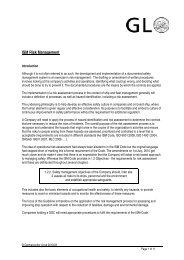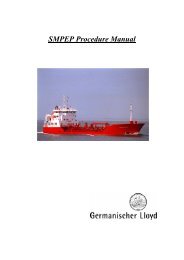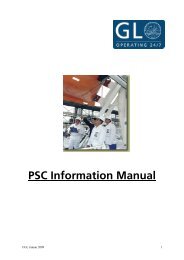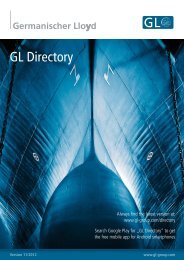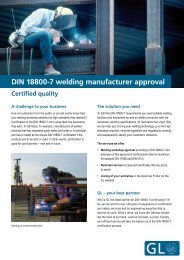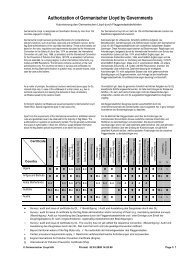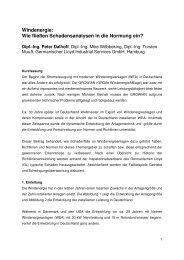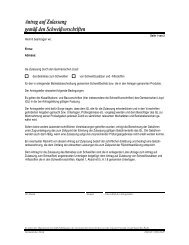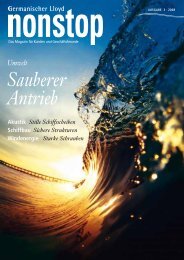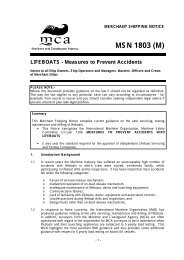Yards Moving Forward - GL Group
Yards Moving Forward - GL Group
Yards Moving Forward - GL Group
You also want an ePaper? Increase the reach of your titles
YUMPU automatically turns print PDFs into web optimized ePapers that Google loves.
OFFSHORE INDUSTRY<br />
Welding Techniques<br />
on the Testbench<br />
In the offshore installations of the oil and gas industry, new types of steel<br />
are coming into use. To ensure the required durability of the installations, the<br />
existing welding techniques have to be adapted.<br />
The demands are becoming tougher and<br />
tougher. Oil and gas companies are drilling<br />
for the black gold in increasingly deep<br />
waters nowadays, because, in view of high prices<br />
on the world market, production may still be profitable<br />
under the most adverse of conditions. At<br />
depths of more than 500 metres, the engineers of<br />
the offshore installations encounter conditions<br />
which call for a change in the material selection.<br />
The risk of damage and repairs must be reduced<br />
drastically, because it would be much too expensive<br />
to tear the pipelines and pumps out of the<br />
seabed for an overhaul ashore. Up until now, the<br />
oil and gas companies have used “C steels” (carbon<br />
steels) wherever possible. However, in strong<br />
concentrations of CO 2 , chlorides and acid gas as<br />
well as at high pressures and temperatures ranging<br />
up to 200 °C – an operating environment which<br />
occurs frequently in deep water – this material is<br />
too susceptible to corrosion. For this reason,<br />
duplex steels must increasingly be used in future<br />
for production and downhole equipment,<br />
pipelines and pressure vessels, as they guarantee<br />
high strength and corrosion resistance at the<br />
same time. Furthermore, these steels must<br />
exhibit balanced grain structure: comprising both<br />
austenite, the main constituent of many stainless<br />
steels, and the higher-tensile ferrite. Today, the<br />
proportion of duplex steels in use is only about<br />
two percent, but “with a strong upwards trend”,<br />
according to Johann Taferner. As a specialized<br />
welding engineer and former design manager for<br />
piping and tank construction, he is now responsible<br />
at Germanischer Lloyd Oil and Gas for the area<br />
of materials, welding and corrosion. In his opinion,<br />
the oil companies, plant construction firms<br />
and welding workshops are inadequately prepared<br />
for the application of duplex steels. “Very often,<br />
austenitic-ferritic duplex steels and austenitic<br />
steels are just lumped together and the literature<br />
references are simply transferred from one materi-<br />
52 nonstop 3/2006<br />
al to the other – with catastrophic results,” says<br />
Taferner. The weak points of the duplex pipelines<br />
are generally the welding seams, “where many<br />
errors are possible in the production process,” the<br />
expert points out. In order that the mechanical<br />
properties and the corrosion resistance of weld<br />
material, heat-affected zone and base material can<br />
agree, the welding consumables must be specially<br />
dosed and a watchful eye must be kept on the temperature<br />
control. Here it is sometimes wrongly<br />
assumed that the duplex steels should be treated<br />
like austenitic steels as regards the welding technology.<br />
At high cooling rates, as is desired for<br />
austenites, a grain structure with a high ferrite<br />
component may be produced, leading to insufficient<br />
corrosion resistance and tenacity. On the<br />
other hand, if cooling rates are too low, then low<br />
strength values and poor resistance to stress corrosion<br />
cracking must be expected. To attain the<br />
desired material properties, a ferrite/austenite<br />
ratio of 50/50 is needed. In the root layer and final<br />
pass, a ferrite content of between 30 and 70 percent<br />
is still acceptable, in Taferner’s view.<br />
In addition, the tarnishes are of particular<br />
importance in respect of corrosion. During welding,<br />
the passive layer of chrome oxide covering the<br />
duplex material around the weld is destroyed and<br />
replaced by other layers rich in iron oxide. These<br />
layers, which are also referred to as heat tinting,<br />
impair the corrosion resistance of the steels.<br />
Through appropriate use of inert gases, these discolourations<br />
can be suppressed to a large degree.<br />
It is not possible to inhibit the tarnish completely,<br />
however. For certain applications, only weak yellow<br />
colours, which arise at temperatures up to<br />
about 400 degrees, may be tolerated. “All other tarnishes<br />
which occur at higher temperatures must<br />
be removed,” Taferner advises. ■ MPH<br />
For furthor information: Johann Taferner, Germanischer Lloyd Oil and Gas,<br />
Phone: +49 40 36149-7739, johann.taferner@gl-group.com






